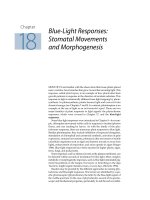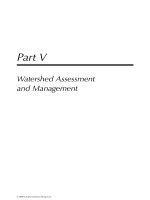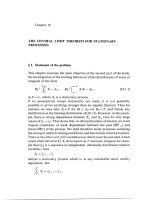chapter 18 externalities and public goods
Bạn đang xem bản rút gọn của tài liệu. Xem và tải ngay bản đầy đủ của tài liệu tại đây (318.2 KB, 62 trang )
Chapter 18
Externalities and
Public Goods
Chapter 18 Slide 2
Topics to be Discussed
Externalities
Ways of Correcting Market Failure
Externalities and Property Rights
Common Property Resources
Chapter 18 Slide 3
Topics to be Discussed
Public Goods
Private Preferences for Public Goods
Chapter 18 Slide 4
Externalities
Negative
Action by one party imposes a cost on
another party
Positive
Action by one party benefits another
party
Chapter 18 Slide 5
External Cost
Scenario
Steel plant dumping waste in a river
The entire steel market effluent can be
reduced by lowering output (fixed
proportions production function)
Chapter 18 Slide 6
External Cost
Scenario
Marginal External Cost (MEC) is the cost
imposed on others for each level of
production.
Marginal Social Cost (MSC) is MC plus
MEC.
MC
S = MC
I
D
P
1
Aggregate
social cost of
negative
externality
P
1
q
1
Q
1
MSC
MSC
I
When there are negative
externalities, the marginal
social cost MSC is higher
than the marginal cost.
External Costs
Firm output
Price
Industry output
Price
MEC
MEC
I
The differences is
the marginal external
cost MEC.
q*
P*
Q*
The industry competitive
output is Q
1
while the efficient
level is Q*.
The profit maximizing firm
produces at q1 while the
efficient output level is q*.
Chapter 18 Slide 8
External Cost
Negative Externalities encourage
inefficient firms to remain in the
industry and create excessive
production in the long run.
Chapter 18 Slide 9
Externalities
Positive Externalities and Inefficiency
Externalities can also result in too little
production, as can be shown in an
example of home repair and
landscaping.
Chapter 18 Slide
10
MC
P
1
External Benefits
Repair Level
Value
D
Is research and development
discouraged by positive
externalities?
q
1
MSB
MEB
When there are positive
externalities (the benefits
of repairs to neighbors),
marginal social benefits
MSB are higher than
marginal benefits D.
q*
P*
A self-interested home owner
invests q
1
in repairs. The
efficient level of repairs
q* is higher. The higher price
P
1
discourages repair.
Chapter 18 Slide
11
Ways of Correcting Market Failure
Assumption: The market failure is
pollution
Fixed-proportion production technology
Must reduce output to reduce
emissions
Use an output tax to reduce output
Input substitution possible by altering
technology
Chapter 18 Slide
12
The Efficient Level of Emissions
Level of Emissions
2
4
6
Dollars
per unit
of Emissions
0 2 4 6 8 10 12 14 16 18 20 22 24 26
MSC
MCA
E*
The efficient level of
emissions is 12 (E*) where
MCA = MSC.
Assume:
1) Competitive market
2) Output and emissions decisions are independent
3) Profit maximizing output chosen
At E
o
the marginal
cost of abating emissions
is greater than the
marginal social cost.
E
0
At E
1
the marginal
social cost is greater
than the marginal benefit.
E
1
Why is this more efficient
than zero emissions?
Chapter 18 Slide
13
Ways of Correcting Market Failure
Options for Reducing Emissions to E*
Emission Standard
Set a legal limit on emissions at E*
(12)
Enforced by monetary and criminal
penalties
Increases the cost of production and
the threshold price to enter the
industry
Chapter 18 Slide
14
Standards and Fees
Level of Emissions
Dollars
per unit
of Emissions
MSC
MCA
3
12
E*
Standard
Fee
Chapter 18 Slide
15
Options for Reducing Emissions to E*
Emissions Fee
Charge levied on each unit of
emission
Ways of Correcting Market Failure
Chapter 18 Slide
16
Total
Abatement Cost
Cost is less than the
fee if emissions were
not reduced.
Total Fee
of Abatement
Standards and Fees
Level of Emissions
Dollars
per unit
of Emissions
MSC
MCA
3
12
E*
Fee
Chapter 18 Slide
17
Standards Versus Fees
Assumptions
Policymakers have asymmetric
information
Administrative costs require the same
fee or standard for all firms
Ways of Correcting Market Failure
Chapter 18 Slide
18
Firm 2’s Reduced
Abatement
Costs
Firm 1’s Increased
Abatement Costs
MCA
1
MCA
2
The Case for Fees
Level of
Emissions
2
4
6
Fee per
Unit of
Emissions
0 1 2 3 4 5 6 7 8 9 10 11 12
13
1
3
5
14
The cost minimizing solution
would be an abatement of 6
for firm 1 and 8 for firm 2 and
MCA
1
= MCA
2
= $3.
3.75
2.50
The impact of a standard of
abatement of 7 for both firms
is illustrated.
Not efficient because
MCA
2
< MCA
1
.
If a fee of $3 was imposed
Firm 1 emissions would fall
by 6 to 8. Firm 2 emissions
would fall by 8 to 6.
MCA
1
= MCA
2
: efficient solution.
Chapter 18 Slide
19
Advantages of Fees
When equal standards must be used,
fees achieve the same emission
abatement at lower cost.
Fees create an incentive to install
equipment that would reduce emissions
further.
Ways of Correcting Market Failure
Chapter 18 Slide
20
ABC is the increase
in social cost less the
decrease in abatement
cost.
Marginal
Social
Cost
Marginal Cost
of Abatement
The Case for Standards
Level of Emissions
Fee per
Unit of
Emissions
0 2 4 6 8 10 12
14 16
2
4
6
8
10
12
14
16
E
Based on incomplete
information standard is 9
(12.5% decrease).
ADE < ABC
D
A
B
C
Based on incomplete
information fee is $7
(12.5% reduction).
Emission increases to 11.
Chapter 18 Slide
21
Summary: Fees vs. Standards
Standards are preferred when MSC is
steep and MCA is flat.
Standards (incomplete information) yield
more certainty on emission levels and
less certainty on the cost of abatement.
Ways of Correcting Market Failure
Chapter 18 Slide
22
Summary: Fees vs. Standards
Fees have certainty on cost and
uncertainty on emissions.
Preferred policy depends on the nature
of uncertainty and the slopes of the cost
curves.
Ways of Correcting Market Failure
Chapter 18 Slide
23
Transferable Emissions Permits
Permits help develop a competitive
market for externalities.
Agency determines the level of
emissions and number of permits
Permits are marketable
High cost firm will purchase permits
from low cost firms
Ways of Correcting Market Failure
Chapter 18 Slide
24
Externalities and Property Rights
Property Rights
Legal rules describing what people or
firms may do with their property
For example
If residents downstream owned the
river (clean water) they control
upstream emissions.
Chapter 18 Slide
25
Bargaining and Economic Efficiency
Economic efficiency can be achieved
without government intervention when
the externality affects relatively few
parties and when property rights are well
specified.
Externalities and Property Rights









